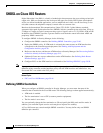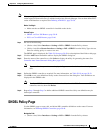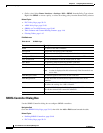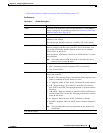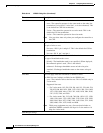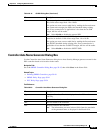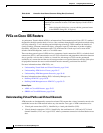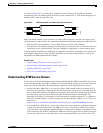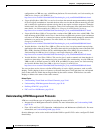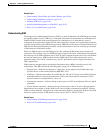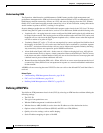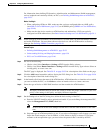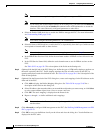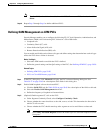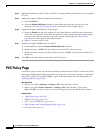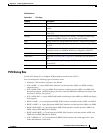
59-48
User Guide for Cisco Security Manager 4.4
OL-28826-01
Chapter 59 Configuring Router Interfaces
PVCs on Cisco IOS Routers
configuration on CBR may vary with different platforms. For more details, see Understanding the
CBR Service Category for ATM VCs at:
http://www.cisco.com/en/US/tech/tk39/tk51/technologies_tech_note09186a0080094e6a.shtml.
• Unspecified Bit Rate (UBR) This is a service class where the network management makes no Quality
of Service (QoS) commitment. It models the best-effort service that the Internet normally provides
and is suitable for applications tolerant to delay that do not require real-time responses. Examples
include email, fax transmission, file transfers, Telnet, LAN and remote office interconnections. For
more details, see Understanding the UBR Service Category for ATM Virtual Circuits at:
http://www.cisco.com/en/US/tech/tk39/tk51/technologies_tech_note09186a00800a4837.shtml.
• Unspecified Bit Rate (UBR+) Cisco provides a variant of the UBR service class called UBR+. The
main advantage of the UBR+ service class is that it allows an ATM end-system to signal a minimum
cell rate to an ATM switch in a connection request, and the ATM network attempts to maintain this
minimum as an end-to-end guarantee. For more details, see Understanding the UBR+ Service
Category for ATM VCs at:
http://www.cisco.com/en/US/tech/tk39/tk51/technologies_tech_note09186a0080094b40.shtml.
• Variable Bit Rate - Non-Real Time (VBR-nrt) This service class is used to transmit non-real-time
applications that are bursty in nature. The traffic characteristics are defined in terms of the Peak Cell
Rate (PCR), Sustained Cell Rate (SCR), and Minimum Burst Size (MBS). For more details, see
Understanding the VBR-nrt Service Category and Traffic Shaping for ATM VCs at:
http://www.cisco.com/en/US/tech/tk39/tk51/technologies_tech_note09186a0080102a42.shtml.
• Variable Bit Rate - Real Time (VBR-rt) This service class is used to transmit real-time data that is
sensitive to time delays, like compressed voice over IP and video conferencing. As with VBR-nrt,
VBR-rt traffic is defined in terms of a PCR, SCR, and MBS. For more details, see Understanding
the Variable Bit Rate Real Time (VBR-rt) Service Category for ATM VCs at:
http://www.cisco.com/en/US/tech/tk39/tk51/technologies_tech_note09186a0080094cd0.shtml.
You can use these service classes to define ATM quality of service (QoS) guarantees, such as traffic
shaping. Traffic shaping is the use of queues to constrain data bursts, limit peak data rate, and smooth
jitter so that traffic fits within the envelope defined by the traffic contract. ATM devices use traffic
shaping to adhere to the terms of the traffic contract.
Related Topics
• Understanding Virtual Paths and Virtual Channels, page 59-46
• Understanding ATM Management Protocols, page 59-48
• Defining ATM PVCs, page 59-50
• PVCs on Cisco IOS Routers, page 59-46
Understanding ATM Management Protocols
ATM uses two different types of signaling for tracking the status of PVCs:
• Integrated Local Management Interface (ILMI). For more information, see Understanding ILMI,
page 59-49.
• Flow 4 (F4) and Flow 5 (F5) Operation, Administration, and Maintenance (OAM) cells. For more
information, see Understanding OAM, page 59-50.
Security Manager can be used to enable and disable ILMI on specific PVCs and to configure F5 OAM
functionality.



